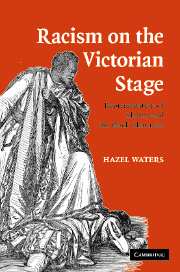Book contents
- Frontmatter
- Contents
- List of illustrations
- Acknowledgements
- Introduction
- 1 From vengeance to sentiment
- 2 The beginning of the end for the black avenger
- 3 Ira Aldridge and the battlefield of race
- 4 The comic and the grotesque: the American influence
- 5 The consolidation of the black grotesque
- 6 Slavery freed from the constraint of blackness
- 7 Uncle Tom – moral high ground or low comedy?
- Afterword
- Notes
- Bibliography
- Index
3 - Ira Aldridge and the battlefield of race
Published online by Cambridge University Press: 22 September 2009
- Frontmatter
- Contents
- List of illustrations
- Acknowledgements
- Introduction
- 1 From vengeance to sentiment
- 2 The beginning of the end for the black avenger
- 3 Ira Aldridge and the battlefield of race
- 4 The comic and the grotesque: the American influence
- 5 The consolidation of the black grotesque
- 6 Slavery freed from the constraint of blackness
- 7 Uncle Tom – moral high ground or low comedy?
- Afterword
- Notes
- Bibliography
- Index
Summary
For all the hyperbole, the rhetoric about liberty and England did have a genuine basis. There was enduring class inequality, but it was a society in which domestic slavery was rarely practised. In this, it contrasted enormously with America, where slavery was the norm in the southern states and, although officially ended in the North by 1830, had been replaced there by a whole raft of discriminatory measures aimed at ensuring black subordination. It is no coincidence that such measures came to be known collectively as ‘Jim Crow’, for that eye-rolling, shoe-shuffling, fast-talking, singing and dancing white parody of black mores began its cultural takeover of American audiences at around the same time. It is the mid-1820s and the English campaign against slavery is once again on the ascendant even as, in America, endemic resistance to slavery is fermenting – most notably in the South in 1822 in a planned, widescale revolt under Denmark Vesey.
Although, at this period, there was a dramatic traffic between England and America, involving plays and star actors (Edmund Kean appeared in New York in 1820), for a black would-be actor, the scope to pursue a career in America was virtually nonexistent. Even the audiences were segregated, blacks being confined to the galleries of theatres like the large and popular Park theatre in New York with its rumbustious working-class audiences.
- Type
- Chapter
- Information
- Racism on the Victorian StageRepresentation of Slavery and the Black Character, pp. 58 - 88Publisher: Cambridge University PressPrint publication year: 2007
- 1
- Cited by



